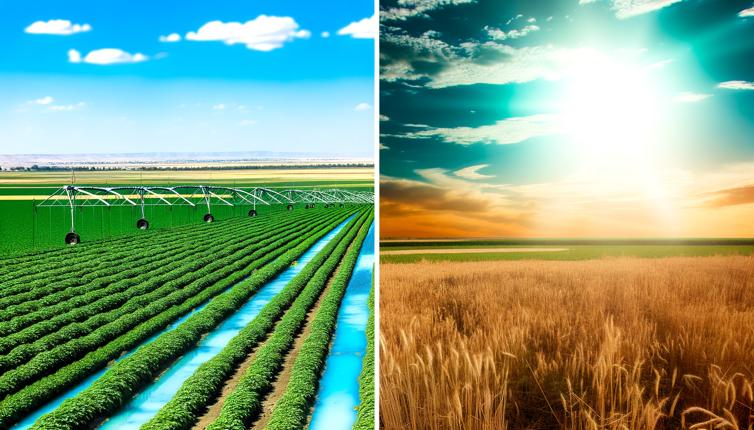Introduction to Farm Management Strategies
Farm management strategies play a crucial role in the success of any agricultural operation. These strategies help farmers make informed decisions on various aspects of their farm, including production, resource allocation, risk management, and sustainability. Two commonly used farm management strategies are intensive farming and extensive farming, each with its own set of advantages and disadvantages.
Understanding Intensive Farming
Intensive farming, also known as high-input farming, involves maximizing the use of available resources to produce high yields in a limited area. It usually involves the use of advanced technology, large amounts of fertilizers and pesticides, and a high level of mechanization. Intensive farming aims to achieve high productivity per unit of land, labor, or capital invested.
Advantages of Intensive Farming
1. High productivity: Intensive farming allows for the production of large quantities of crops or livestock in a relatively small area, leading to higher overall productivity.,2. Increased profitability: The high yields obtained through intensive farming can result in increased profitability for farmers.,3. Efficient resource utilization: Intensive farming techniques optimize the use of resources such as water, fertilizers, and energy, minimizing waste and reducing environmental impact.,4. Better disease and pest control: The use of pesticides and monitoring systems in intensive farming helps control the spread of diseases and pests, resulting in healthier crops and livestock.
Disadvantages of Intensive Farming
1. Environmental impact: Intensive farming practices can have negative effects on the environment, including soil degradation, water pollution, and depletion of natural resources.,2. Health concerns: The use of chemicals in intensive farming can have health implications for farmers and consumers if not properly managed.,3. Increased dependency on inputs: Intensive farming relies heavily on external inputs, such as fertilizers and pesticides, which can be costly and subject to price fluctuations.,4. Animal welfare concerns: Intensive animal farming systems often involve confined spaces and limited natural behaviors, raising concerns about animal welfare.
Understanding Extensive Farming
Extensive farming, also known as low-input farming, involves using large areas of land with lower levels of inputs, such as fertilizers and pesticides, to produce crops or livestock. It relies more on natural processes and less on technology and mechanization.,Extensive farming is often practiced in areas with low population density, where there is ample land available for agriculture.
Advantages of Extensive Farming
1. Lower environmental impact: Extensive farming practices have a lower environmental impact compared to intensive farming, as they rely less on synthetic inputs and large-scale mechanization.,2. Preservation of biodiversity: Extensive farming systems often maintain a higher level of biodiversity, as they provide habitats for various plant and animal species.,3. Reduced dependency on external inputs: Extensive farming relies more on natural processes, reducing the need for costly external inputs and minimizing the risks associated with price fluctuations.,4. Improved animal welfare: Extensive animal farming systems typically allow for more natural behaviors and provide animals with access to pasture or open spaces, promoting better animal welfare.
Disadvantages of Extensive Farming
1. Lower productivity: Extensive farming systems generally have lower yields per unit of land compared to intensive farming, which can limit overall productivity and profitability.,2. Land requirements: Extensive farming requires larger land areas compared to intensive farming, which may not be feasible in areas with limited available land.,3. Vulnerability to climate and environmental changes: Extensive farming systems may be more vulnerable to climate variations and environmental changes, as they rely more on natural processes that can be affected by external factors.,4. Longer production cycles: Extensive farming often requires longer production cycles compared to intensive farming, which can result in slower response times to market demands.
Choosing the Best Fit for Your Farm
When deciding between intensive and extensive farming, it is essential to consider various factors, such as the characteristics of your farm, market conditions, resource availability, and your personal goals and values as a farmer.,Some key points to consider include:,- Farm size and available land: If you have limited land resources, intensive farming may be more suitable, as it allows for higher yields in smaller areas.,- Resource availability: If you have access to ample resources such as water, fertilizers, and energy, intensive farming can help maximize their utilization.,- Market demand: Consider the market demand for your products. If there is a high demand for high-quality, organic, or sustainably produced crops or livestock, extensive farming methods may be more suitable.,- Personal preferences and values: Your personal goals and values as a farmer also play a significant role in deciding which farming method aligns better with your vision.,Ultimately, there is no one-size-fits-all approach, and a combination of intensive and extensive farming techniques may be the best fit for some farmers, depending on their specific circumstances.
Conclusion
In conclusion, choosing between intensive and extensive farming depends on various factors, including farm characteristics, resource availability, market demand, and personal values. Both farming strategies have their own set of advantages and disadvantages, and the best fit for a farmer is determined by considering these factors. It is important for farmers to regularly assess their farm management strategies and adapt them to changing circumstances to ensure the long-term success and sustainability of their operations.









